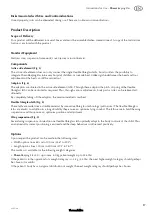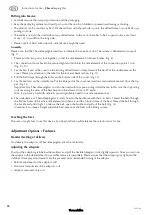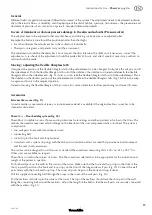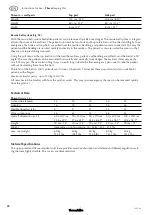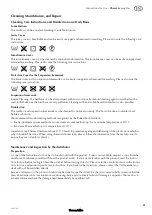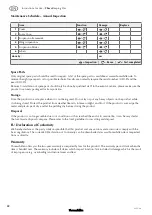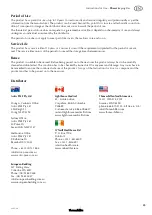
2021-04
General
Different fields of application require different adjustments of the system. The adjustment needs to be adapted individu-
ally to the kind of illness or disability, and the physique of the child. Gibbus, spasticity, skin diseases, the prevention and
treatment of pressure ulcers, reduction of pain etc. require different adjustments.
In case of imminent or obvious pressure damage to the skin and subcutis (Pressure ulcer)
The adaptors have to be adjusted in that way that heavy and sticking out body areas are adjusted softer.
Example: the buttock zone should be positioned softer than the thighs.
• For other illnesses the adjustment has to be carried out individually.
• Therapists, caregivers, and parents carry out the assessment.
The adjustments should be checked after 1 hour. Inspect the skin, interview the child, and, if necessary, correct the
adjustments. A re-check of the adjustments should be made after 24 hours, and after 1 week; if necessary, another cor-
rection should be made.
Moving / adjusting the flexible fibreglass lath
If required, the position of the flexible fibreglass lath in the side element can be changed. Firstly, take the adaptor out off
the side element. Push the flexible fibreglass lath out off the stabiliser (the stabiliser is situated underneath the flexible
fibreglass lath in the side element). (Fig. 15) Now you can take the flexible fibreglass lath out off the side element. Place
the stabiliser in the desired position of the side element and slide in the flexible fibreglass lath. (Fig. 16) Put in the adap-
tor again and turn it to the required position.
Instead of moving the flexible fibreglass lath you can also create softer areas (hollow positioning) and more stiff areas.
Accessories
Extra mattress cover (Fig. 17)
An extra mattress cover made of jersey or incontinence material is available if the original mattress cover has to be
cleaned or discarded.
Thevo
Floor
– Floor bedding system (Fig. 18)
ThevoFloor is suitable for use at home and in professional care settings and allows patients to lie low to the floor. This
reduces the need for measures which infringe on the freedom of the user and prevents falls out of bed. The system is
comprised of:
• two wall parts (foam with incontinence cover)
• connecting belt
• cover strip for the hook and loop fastener
• A mattress and a system of springs with the MiS micro-stimulation effect are used that promote natural movement
and the user’s body awareness.
The system can be designed to suit the user. A standard Thevo mattress measuring 140 x 200 cm / 55.1 x 78.7" fits.
Other sizes are available on request.
ThevoFloor is used in the corners of rooms. The Thevo mattress selected has to be appropriate for the indication and
weight of the patient in question.
Put both wall parts on the walls in the corner of the room. Make sure that the hook and loop strip on the front of the
short, top-wall part faces the hook and loop strips on the front of the longer side wall part (Fig. 19). Connect the wall
parts firmly with the hook and loop strip. The cover strip can be put on the hook and loop fastener.
Pull the supplied connecting belt through the loops in the cover of the wall parts (Fig. 20).
Put the mattress red side up in the corner of the room. The top of the mattress should face the short part of the wall.
Bring the connecting belt around the mattress. Adjust the length of the belt so that the wall parts are securely connected
with the mattress (Fig. 21).
Instructions for Use –
Thevo
Sleeping Star
19













